The ENTC now has a new website, at www.entc.org.sz
Our logo is adapted from a painting by Phillip Dlamini, 1998, of a purple crested turaco. In traditional Swazi dress, the red feathers feature in the royal headdress, so this bird illustration is not only a symbol for wildlife conservation, but also of cultural heritage.
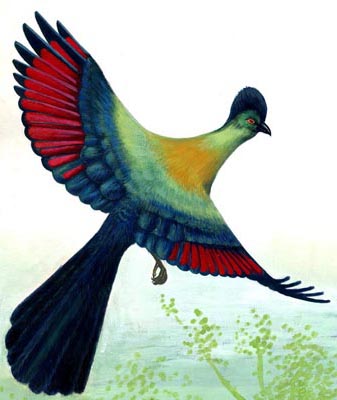

The principle Swazi social unit remains the homestead. The traditional beehive hut is thatched with dry grass. In a polygamous homestead, each wife normally has her own huts and yard surrounded by reed fences for privacy. These comprise three structures mainly for sleeping, cooking and storage (brewing beer). In substantial homesteads there will also be structures used as bachelors' quarters and guest accommodation. Central to the traditional homestead is the cattle byre, a circular area enclosed by substantial logs interspaced with branches. The cattle byre has great ritual as well as practical significance as a store of wealth and symbol of prestige. It contains sealed grain pits. Facing the cattle byre is the great hut which is occupied by the mother of the headman.
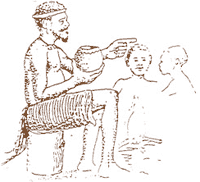
The headman is central to all homestead affairs. He leads through example and advises his wife on all social affairs of the home as well as seeing to the larger survival of the family. He also spends time socialising with the young boys, who are ofthen his sons or close relatives, talking about the expectations of growing up and manhood.
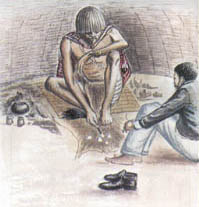
The Sangoma is a traditional diviner chosen by the ancestors of that particular family. The training of the Sangoma is called "kwetfwasa". At the end of the training, there is a graduation ceremony where all the local tangoma come together for feasting and dancing. The diviner is consulted for various reasons pertaining to the cause of sickness or even death. His diagnosis is based on "kubhula", a process of communication, through trance, with the natural super-powers. The Inyanga (a medical and pharmaceutical specialist in modern terms) possesses the bone throwing skill ("kushaya ematsambo") used to determine the cause of the sickness.
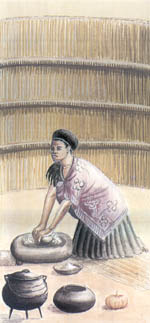
Various activities are performed along gender lines, for example, the griding of mealies remains the preserve of women. This is prior to the preparation of Swazi food.
sishwala- thick porridge normally served with meat or vegetables
incwancwa - sour porridge made of fermented mealie meal
sitfubi - fresh milk cooked and mixed with mealie meal
siphuphe - setindlubu thick porridge made of mashed groundnuts
emasi etinkhobe temmbila - ground mealies mixed with sour milk
emasi emabele - ground sorghum mixed with sour milk
sidvudvu - porridge made of pumpkin mixed with mealie meal
umncweba - dried uncooked meat (biltong)
umkhunsu - cooked and dried meat
siphuphe semabhontjisi - thick porridge made of mashed beans
tinkhobe - boiled whole maize
umbidvo wetintsanga - cooked pumpkin tops (leaves) mixed with groundnuts
tjwala (umcombotsi) - traditional beer

It is a Swazi dance which celebrates feminine beauty and virtue. It is performed by unmarried girls dressed only in brief beaded aprons and adornments. It takes the pattern of a beautiful rhythm accompanied by songs with various meanings composed according to the occasions.
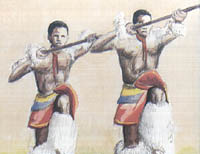
The Sibhaca, a foot stamping dance, vigorous in style, is performed by teams of men throughout the country. The rhythm and spectacular physique of the men when performing causes wonder and admiration from the spectators. Sibhaca dance is sometimes performed as a competition or just for fun, depending on the occasion.

The warriors dress in gaily patterned cloths (emahiya) with loinskins and anklets, decorated with feathers and beads, carrying a knobkerrie and a traditional shield for defence purposes. In early days the army of warriors were needed to suppress any form of rebellion from conquered tribes, to protect the king and nation from rivals and external attacks. Nowadays they do tasks associated with the incwala ceremony.
| Some Swazi Words | |
| Sawubona | Hello |
| Unjani | How are you |
| Ngiyaphila | I am fine |
| Ngiyabonga | Thank you |
| Wota lapha | Come here |
| Sikhulekile ekhaya | A Swazi way of greeting a home as well as asking for permission to enter. |
| Sala kahle | Stay well |
| Hamba kahle | Go well |
Our Contacts:
Head Quarters: (+268) 2416 1489/1179
Email: info@sntc.org.sz
King Sobhuza II Park: (+268) 2416 1489/1179
Email: ksmp@sntc.org.sz
National Museum: (+268) 2416 1489/1179
Email: curator@sntc.org.sz
Copyright © ESWATINI NATIONAL TRUST COMMISSION
Malolotja Nature Reserve: (+268) 2444 3241 / (+268) 2416 1480
Email: culturalvillage@sntc.org.sz
Mantenga Nature Reserve and Swati Cultural Village: 2416 1151/1178
Email: culturalvillage@sntc.org.sz
Mlawula Nature Reserve: (+268) 2383 8885 (Reception)
(+268) 2383 8453 (Senior Warden)
Email: culturalvillage@sntc.org.sz
Magadzavane Lodge: (+268) 2343 5108/9
Email: magadzavane@sntc.org.sz